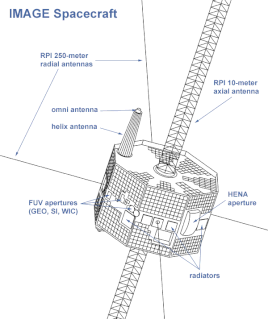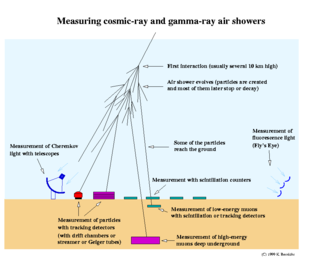The Geiger Tube Telescope is a scientific instrument that measures the intensities, energy spectra, and angular distribution of energetic electrons and protons in interplanetary space and near Jupiter and Saturn.

The electron is a subatomic particle, symbol
e−
or
β−
, whose electric charge is negative one elementary charge. Electrons belong to the first generation of the lepton particle family, and are generally thought to be elementary particles because they have no known components or substructure. The electron has a mass that is approximately 1/1836 that of the proton. Quantum mechanical properties of the electron include an intrinsic angular momentum (spin) of a half-integer value, expressed in units of the reduced Planck constant, ħ. As it is a fermion, no two electrons can occupy the same quantum state, in accordance with the Pauli exclusion principle. Like all elementary particles, electrons exhibit properties of both particles and waves: they can collide with other particles and can be diffracted like light. The wave properties of electrons are easier to observe with experiments than those of other particles like neutrons and protons because electrons have a lower mass and hence a longer de Broglie wavelength for a given energy.

A proton is a subatomic particle, symbol
p
or
p+
, with a positive electric charge of +1e elementary charge and a mass slightly less than that of a neutron. Protons and neutrons, each with masses of approximately one atomic mass unit, are collectively referred to as "nucleons".

Jupiter is the fifth planet from the Sun and the largest in the Solar System. It is a giant planet with a mass one-thousandth that of the Sun, but two-and-a-half times that of all the other planets in the Solar System combined. Jupiter and Saturn are gas giants; the other two giant planets, Uranus and Neptune, are ice giants. Jupiter has been known to astronomers since antiquity. It is named after the Roman god Jupiter. When viewed from Earth, Jupiter can reach an apparent magnitude of −2.94, bright enough for its reflected light to cast shadows, and making it on average the third-brightest natural object in the night sky after the Moon and Venus.
On Pioneer 10, the instrument used an array of seven miniature Geiger-Müller tubes, collectively known as a Geiger Tube Telescope (GTT). Each tube was a small gas-filled cylinder. When a charged particle passed through the gas, an electrical pulse was generated by the applied voltage. Individual pulses from five of the tubes and coincident pulses from three combinations of the seven tubes were transmitted. Protons of energy greater than 5 MeV and electrons with energies greater 40 keV were detected.

Pioneer 10 is an American space probe, launched in 1972 and weighing 258 kilograms, that completed the first mission to the planet Jupiter. Thereafter, Pioneer 10 became the first of five artificial objects to achieve the escape velocity that will allow them to leave the Solar System. This space exploration project was conducted by the NASA Ames Research Center in California, and the space probe was manufactured by TRW Inc.
In physics, the electronvolt is a unit of energy equal to approximately 1.6×10−19 joules in SI units.
On Pioneer 11, one Geiger-Müller tube was replaced by a thin silicon wafer to detect protons in the specific energy range 0.61 to 3.41 MeV. Other minor changes were made to improve the characteristics of the detector system.

Pioneer 11 is a 259-kilogram (571 lb) robotic space probe launched by NASA on April 6, 1973 to study the asteroid belt, the environment around Jupiter and Saturn, solar wind and cosmic rays. It was the first probe to encounter Saturn and the second to fly through the asteroid belt and by Jupiter. Thereafter, Pioneer 11 became the second of five artificial objects to achieve the escape velocity that will allow them to leave the Solar System. Due to power constraints and the vast distance to the probe, the last routine contact with the spacecraft was on September 30, 1995, and the last good engineering data was received on November 24, 1995.
The trains of pulses were passed through quasi-logarithmic data processors and then to the radio telemetry system of the spacecraft. Angular distributions were measured as the spacecraft rotated. This telemetry data was transmitted to the earth by an 8 watt S band transmitter within the Pioneer probe at one of eight data rates (from 16 to 2048 bits per second).

Telemetry is an automated communications process by which measurements and other data are collected at remote or inaccessible points and transmitted to receiving equipment for monitoring. The word is derived from Greek roots: tele = remote, and metron = measure. Systems that need external instructions and data to operate require the counterpart of telemetry, telecommand.
The S band is a designation by the Institute of Electrical and Electronics Engineers (IEEE) for a part of the microwave band of the electromagnetic spectrum covering frequencies from 2 to 4 gigahertz (GHz). Thus it crosses the conventional boundary between the UHF and SHF bands at 3.0 GHz. The S band is used by airport surveillance radar for air traffic control, weather radar, surface ship radar, and some communications satellites, especially those used by NASA to communicate with the Space Shuttle and the International Space Station. The 10 cm radar short-band ranges roughly from 1.55 to 5.2 GHz. The S band also contains the 2.4–2.483 GHz ISM band, widely used for low power unlicensed microwave devices such as cordless phones, wireless headphones (Bluetooth), wireless networking (WiFi), garage door openers, keyless vehicle locks, baby monitors as well as for medical diathermy machines and microwave ovens. India’s regional satellite navigation network (IRNSS) broadcasts on 2.483778 to 2.500278 GHz.

In electronics and telecommunications, a transmitter or radio transmitter is an electronic device which produces radio waves with an antenna. The transmitter itself generates a radio frequency alternating current, which is applied to the antenna. When excited by this alternating current, the antenna radiates radio waves.

















